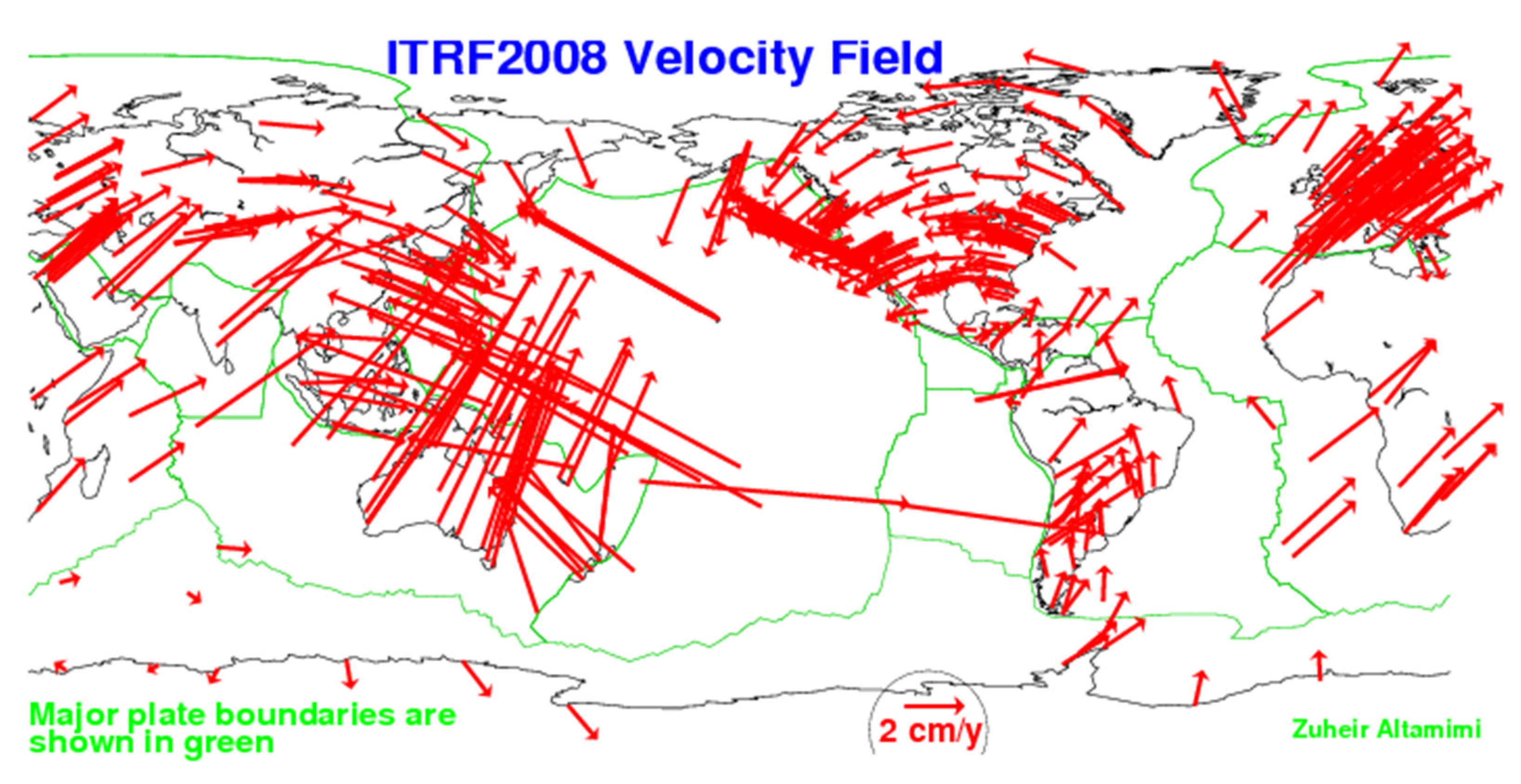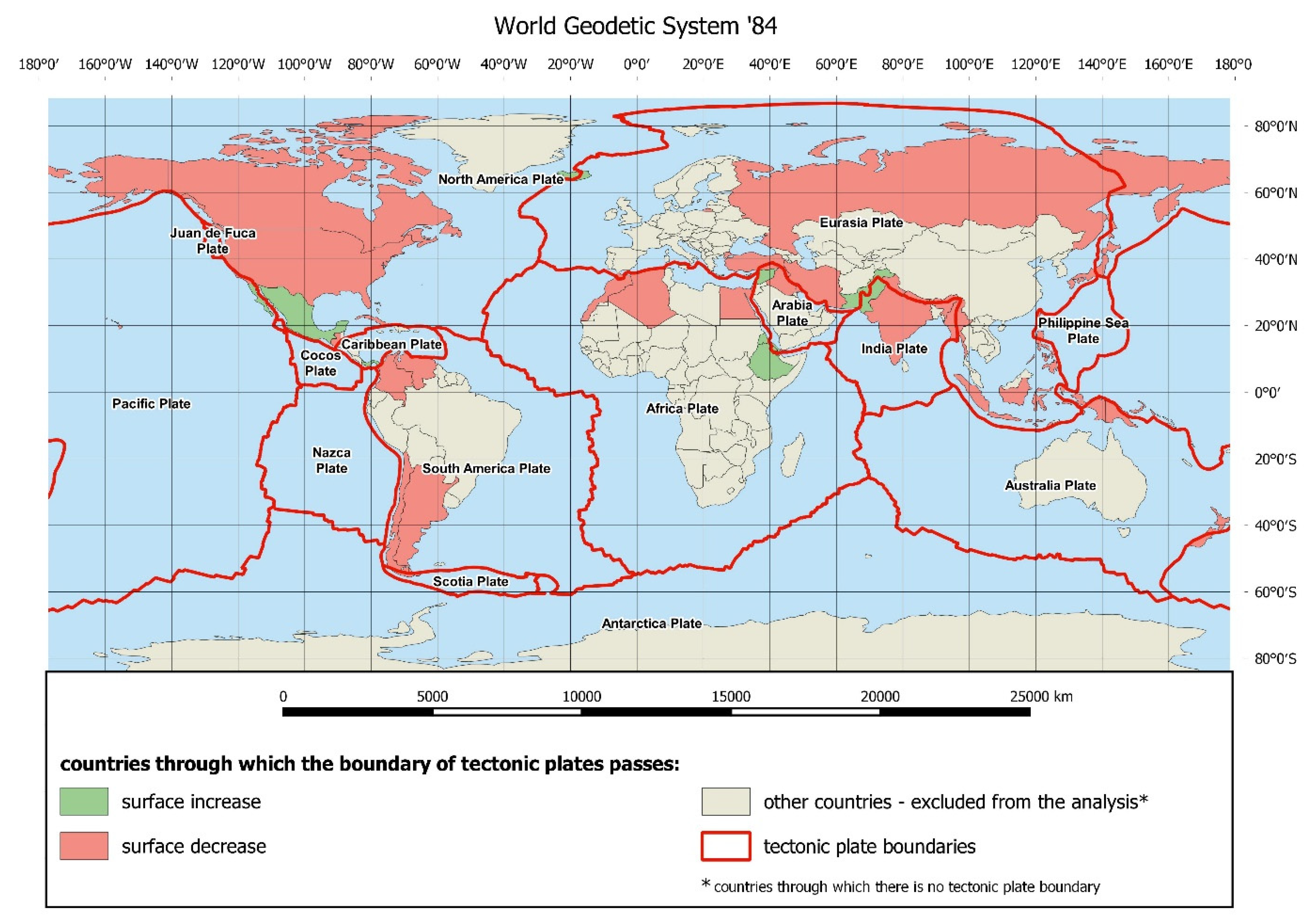What Is the Impact of Tectonic Plate Movement on Country Size? A Long-Term Forecast
Abstract
:1. Introduction
2. Methods and Limitations
3. Results and Discussion
4. Conclusions
Supplementary Materials
Author Contributions
Funding
Institutional Review Board Statement
Informed Consent Statement
Data Availability Statement
Acknowledgments
Conflicts of Interest
References
- Williamson, I.; Enemark, S.; Wallace, J.; Rajabifard, A. Land Administration for Sustainable Development; ESRI Press Academic: Redlands, CA, USA, 2010; ISBN 9781589480414. [Google Scholar]
- Donchyts, G.; Baart, F.; Winsemius, H.; Gorelick, N.; Kwadijk, J.; van de Giesen, N. Earth’s surface water change over the past 30 years. Nat. Clim. Chang. 2016, 6, 810–813. [Google Scholar] [CrossRef]
- Siegert, M. Sea Level Change; PM Cambridge University Press: London, UK, 2015; Available online: https://www.imperial.ac.uk/media/imperial-college/grantham-institute/public/publications/briefing-papers/Sea-level-change-Briefing-Note-1v2.pdf (accessed on 11 September 2021).
- Nerem, R.S.; Beckley, B.D.; Fasullo, J.T.; Hamlington, B.D.; Masters, D.; Mitchum, G.T. Climate-change–driven accelerated sea-level rise detected in the altimeter era. Proc. Natl. Acad. Sci. USA 2018, 115, 2022–2025. [Google Scholar] [CrossRef] [PubMed] [Green Version]
- Widlansky, M.J.; Long, X.; Schloesser, F. Increase in sea level variability with ocean warming associated with the nonlinear thermal expansion of seawater. Commun. Earth Environ. 2020, 1, 1–12. [Google Scholar] [CrossRef]
- Peltier, W. Chapter 4 Global glacial isostatic adjustment and modern instrumental records of relative sea level history. Int. Geophys. 2001, 75, 65–95. [Google Scholar] [CrossRef]
- Morgan, W.J.; Shagam, R.; Hargraves, R.B.; Van Houten, F.B.; Burk, C.A.; Holland, H.D.; Hollister, L.C. Plate Motions and Deep Mantle Convection. Mem. Geol. Soc. Am. 1972, 132, 7–22. [Google Scholar] [CrossRef]
- Harrison, C.G.A. The present-day number of tectonic plates. Earth Planets Space 2016, 68, 450. [Google Scholar] [CrossRef] [Green Version]
- Hejmanowski, R.; Malinowska, A.A.; Witkowski, W.T.; Guzy, A. An Analysis Applying InSAR of Subsidence Caused by Nearby Mining-Induced Earthquakes. Geosciences 2019, 9, 490. [Google Scholar] [CrossRef] [Green Version]
- Matwij, W.; Gruszczyński, W.; Puniach, E.; Ćwiąkała, P. Determination of underground mining-induced displacement field using multi-temporal TLS point cloud registration. Measurement 2021, 180, 109482. [Google Scholar] [CrossRef]
- Ramalho, R.S.; Quartau, R.; Trenhaile, A.S.; Mitchell, N.C.; Woodroffe, C.D.; Ávila, S.P. Coastal evolution on volcanic oceanic islands: A complex interplay between volcanism, erosion, sedimentation, sea-level change and biogenic production. Earth-Sci. Rev. 2013, 127, 140–170. [Google Scholar] [CrossRef] [Green Version]
- Mentaschi, L.; Vousdoukas, M.I.; Pekel, J.-F.; Voukouvalas, E.; Feyen, L. Global long-term observations of coastal erosion and accretion. Sci. Rep. 2018, 8, 12876. [Google Scholar] [CrossRef] [Green Version]
- UNAVCO. Plate Motion Calculator. Available online: https://www.unavco.org/software/geodetic-utilities/plate-motion-calculator/plate-motion-calculator.html#references (accessed on 11 September 2021).
- Wallace, R.E. The San Andreas Fault System; US Geological Survey, United States Government Printing Office: Washington, DC, USA, 1990; p. 1515.
- Thornton, J. Field Guide to New Zealand Geology: An Introduction to Rocks, Minerals and Fossils; Penguin Group New Zealand, Limited: Auckland, New Zealand, 1985; ISBN 10: 0790000253, ISBN 13: 9780790000251. [Google Scholar]
- Jagoda, M.; Rutkowska, M. An Analysis of the Eurasian Tectonic Plate Motion Parameters Based on GNSS Stations Positions in ITRF2014. Sensors 2020, 20, 6065. [Google Scholar] [CrossRef] [PubMed]
- Ampatzidis, D. Alternative methodology for classical geodetic reference system assessment using GNSS and recent tectonic plate model: Case of hellenic geodetic reference system of 1987. Surv. Rev. 2014, 47, 363–370. [Google Scholar] [CrossRef]
- Wang, G.; Kearns, T.J.; Yu, J.; Saenz, G. A stable reference frame for landslide monitoring using GPS in the Puerto Rico and Virgin Islands region. Landslides 2014, 11, 119–129. [Google Scholar] [CrossRef]
- Pospíšil, L.; Hefty, J.; Hipmanová, L. Risk and geodynamically active areas of the carpathian lithosphere on the base of geodetical and geophysical data. Acta Geod. Geophys. Hung. 2012, 47, 287–309. [Google Scholar] [CrossRef]
- Bird, P. An updated digital model of plate boundaries. Geochem. Geophys. Geosystems 2003, 4. [Google Scholar] [CrossRef]
- DeMets, C.; Gordon, R.G.; Argus, D.F.; Stein, S. Effect of recent revisions to the geomagnetic reversal time scale on estimates of current plate motions. Geophys. Res. Lett. 1994, 21, 2191–2194. [Google Scholar] [CrossRef]
- Argus, D.F.; Gordon, R.G.; Heflin, M.B.; Ma, C.; Eanes, R.J.; Willis, P.; Peltier, W.R.; Owen, S.E. The angular velocities of the plates and the velocity of Earth’s centre from space geodesy. Geophys. J. Int. 2010, 180, 913–960. [Google Scholar] [CrossRef]
- Argus, D.F.; Gordon, R.G.; DeMets, C. Geologically current motion of 56 plates relative to the no-net-rotation reference frame. Geochem. Geophys. Geosystems 2011, 12. [Google Scholar] [CrossRef] [Green Version]
- GISCO data distribution API, Eurostat Countries 2020. EN: © EuroGeographics for the Administrative Boundaries. Available online: https://ec.europa.eu/eurostat/web/gisco/geodata/reference-data/administrative-units-statistical-units/countries (accessed on 11 September 2021).
- Kostelecký, J.; Zeman, A. Horizontal and vertical displacements of the stations within the frame of the individual plates based on the ITRS 2000 reference system. Acta Geodyn. Geomater. 2004, 1, 133–143. [Google Scholar]
- Le Fort, P. Himalayas: The collided range. Present knowledge of the continental arc. Am. J. Sci. 1975, 275, 1–44. [Google Scholar]
- Beaumont, C.; Jamieson, R.A.; Nguyen, M.H.; Lee, B. Himalayan tectonics explained by extrusion of a low-viscosity crustal channel coupled to focused surface denudation. Nat. Cell Biol. 2001, 414, 738–742. [Google Scholar] [CrossRef] [PubMed]
- Sreejith, K.M.; Sunil, P.S.; Agrawal, R.; Saji, A.P.; Rajawat, A.S.; Ramesh, D.S. Audit of stored strain energy and extent of future earthquake rupture in central Himalaya. Sci. Rep. 2018, 8, 16697. [Google Scholar] [CrossRef] [PubMed]
- Valagussa, A.; Frattini, P.; Valbuzzi, E.; Crosta, G.B. Role of landslides on the volume balance of the Nepal 2015 earthquake sequence. Sci. Rep. 2021, 11, 1–12. [Google Scholar] [CrossRef]
- Watanabe, S.-I.; Ishikawa, T.; Yokota, Y. Non-volcanic crustal movements of the northernmost Philippine Sea plate detected by the GPS-acoustic seafloor positioning. Earth Planets Space 2015, 67, 119. [Google Scholar] [CrossRef] [Green Version]
- Briole, P.; Ganas, A.; Elias, P.; Dimitrov, D. The GPS velocity field of the Aegean. New observations, contribution of the earthquakes, crustal blocks model. Geophys. J. Int. 2021, 226, 468–492. [Google Scholar] [CrossRef]
- Kingston, A. Ring of fire: An encyclopedia of the Pacific Rim’s earthquakes, tsunamis, and volcanoes. Choice Rev. Online 2015, 53, 53. [Google Scholar] [CrossRef]
- Tary, J.B.; Herrera, R.H.; Van Der Baan, M. Analysis of time-varying signals using continuous wavelet and synchrosqueezed transforms. Philos. Trans. R. Soc. A Math. Phys. Eng. Sci. 2018, 376, 20170254. [Google Scholar] [CrossRef] [PubMed] [Green Version]
- Largest Countries in the World (by Area). Available online: https://www.worldometers.info/geography/largest-countries-in-the-world/ (accessed on 11 September 2021).
- Data.ca.gov. CA Geographic Boundaries. Available online: https://data.ca.gov/dataset/ca-geographic-boundaries (accessed on 11 September 2021).


| # | Country | Area * [km2] | Plate Border Length [km] | Area Change [m2] | ||
|---|---|---|---|---|---|---|
| After 10 Years | After 25 Years | After 50 Years | ||||
| 1 | Algeria | 2,381,740 | 379 | −36,810 | −97,691 | −198,668 |
| 2 | Argentina | 2,736,690 | 129 | −4948 | −4324 | −6211 |
| 3 | Bhutan | 38,117 | 301 | −92,220 | −230,263 | −460,291 |
| 4 | Canada | 9,093,510 | 213 | −15,299 | −27,806 | −51,226 |
| 5 | Chile | 743,532 | 185 | −23,445 | −64,963 | −132,276 |
| 6 | Colombia | 1,109,500 | 104 | −76,446 | −190,891 | −380,949 |
| 7 | Cuba | 106,440 | 178 | −1421 | −1467 | −1776 |
| 8 | Djibouti | 23,180 | 136 | 9086 | 22,725 | 45,720 |
| 9 | Egypt | 995,450 | 136 | −2268 | 435 | 6756 |
| 10 | Eritrea | 101,000 | 132 | 2502 | 6053 | 11,909 |
| 11 | Ethiopia | 1,000,000 | 473 | 3779 | 7076 | 12,951 |
| 12 | Guatemala | 107,160 | 287 | −4940 | −12,459 | −24,680 |
| 13 | Iceland | 100,250 | 476 | 56,598 | 140,186 | 279,317 |
| 14 | India | 2,973,190 | 1440 | −575,659 | −1,440,931 | −2,882,874 |
| 15 | Indonesia | 1,811,570 | 494 | −30,600 | −75,692 | −157,201 |
| 16 | Iran | 1,628,550 | 1547 | −140,679 | −353,301 | −707,640 |
| 17 | Iraq | 434,320 | 396 | −15,813 | −37,491 | −72,812 |
| 18 | Israel | 21,640 | 299 | −18,467 | −47,167 | −94,828 |
| 19 | Japan | 364,555 | 335 | −67,176 | −161,376 | −310,598 |
| 20 | Lebanon | 10,230 | 165 | −2520 | −6627 | −13,445 |
| 21 | Mexico | 1,943,950 | 172 | 13,265 | 33,167 | 64,839 |
| 22 | Morocco | 446,300 | 425 | −1486 | −75 | 2565 |
| 23 | Myanmar | 653,290 | 1375 | −55,878 | −147,914 | −299,340 |
| 24 | Nepal | 143,350 | 878 | −391,615 | −979,922 | −1,960,880 |
| 25 | New Zealand | 263,310 | 535 | −122,850 | −306,878 | −605,524 |
| 26 | Pakistan | 770,880 | 1774 | −132,438 | −331,018 | −660,850 |
| 27 | Panama | 74,340 | 180 | 1938 | 3122 | 5527 |
| 28 | Papua New Guinea | 452,860 | 488 | −115,344 | −295,920 | −594,725 |
| 29 | Philippines | 298,170 | 152 | −121,255 | −303,453 | −607,910 |
| 30 | Russia | 16,376,870 | ,592 | −31,186 | −96,717 | −213,285 |
| 31 | Syria | 183,630 | 159 | 1062 | 2057 | 4148 |
| 32 | Taiwan | 35,410 | 382 | −236 | 171 | 2917 |
| 33 | Trinidad and Tobago | 5130 | 82 | −639 | −4964 | −12,244 |
| 34 | Turkey | 769,630 | 904 | −181,182 | −454,212 | −908,848 |
| 35 | USA | 9,147,420 | 1495 | −210,355 | −536,560 | −1,085,144 |
| 36 | Venezuela | 882,050 | 227 | −46,416 | −117,708 | −237,105 |
Publisher’s Note: MDPI stays neutral with regard to jurisdictional claims in published maps and institutional affiliations. |
© 2021 by the authors. Licensee MDPI, Basel, Switzerland. This article is an open access article distributed under the terms and conditions of the Creative Commons Attribution (CC BY) license (https://creativecommons.org/licenses/by/4.0/).
Share and Cite
Maciuk, K.; Apollo, M.; Kukulska-Kozieł, A.; Lewińska, P. What Is the Impact of Tectonic Plate Movement on Country Size? A Long-Term Forecast. Remote Sens. 2021, 13, 4872. https://doi.org/10.3390/rs13234872
Maciuk K, Apollo M, Kukulska-Kozieł A, Lewińska P. What Is the Impact of Tectonic Plate Movement on Country Size? A Long-Term Forecast. Remote Sensing. 2021; 13(23):4872. https://doi.org/10.3390/rs13234872
Chicago/Turabian StyleMaciuk, Kamil, Michal Apollo, Anita Kukulska-Kozieł, and Paulina Lewińska. 2021. "What Is the Impact of Tectonic Plate Movement on Country Size? A Long-Term Forecast" Remote Sensing 13, no. 23: 4872. https://doi.org/10.3390/rs13234872
APA StyleMaciuk, K., Apollo, M., Kukulska-Kozieł, A., & Lewińska, P. (2021). What Is the Impact of Tectonic Plate Movement on Country Size? A Long-Term Forecast. Remote Sensing, 13(23), 4872. https://doi.org/10.3390/rs13234872






